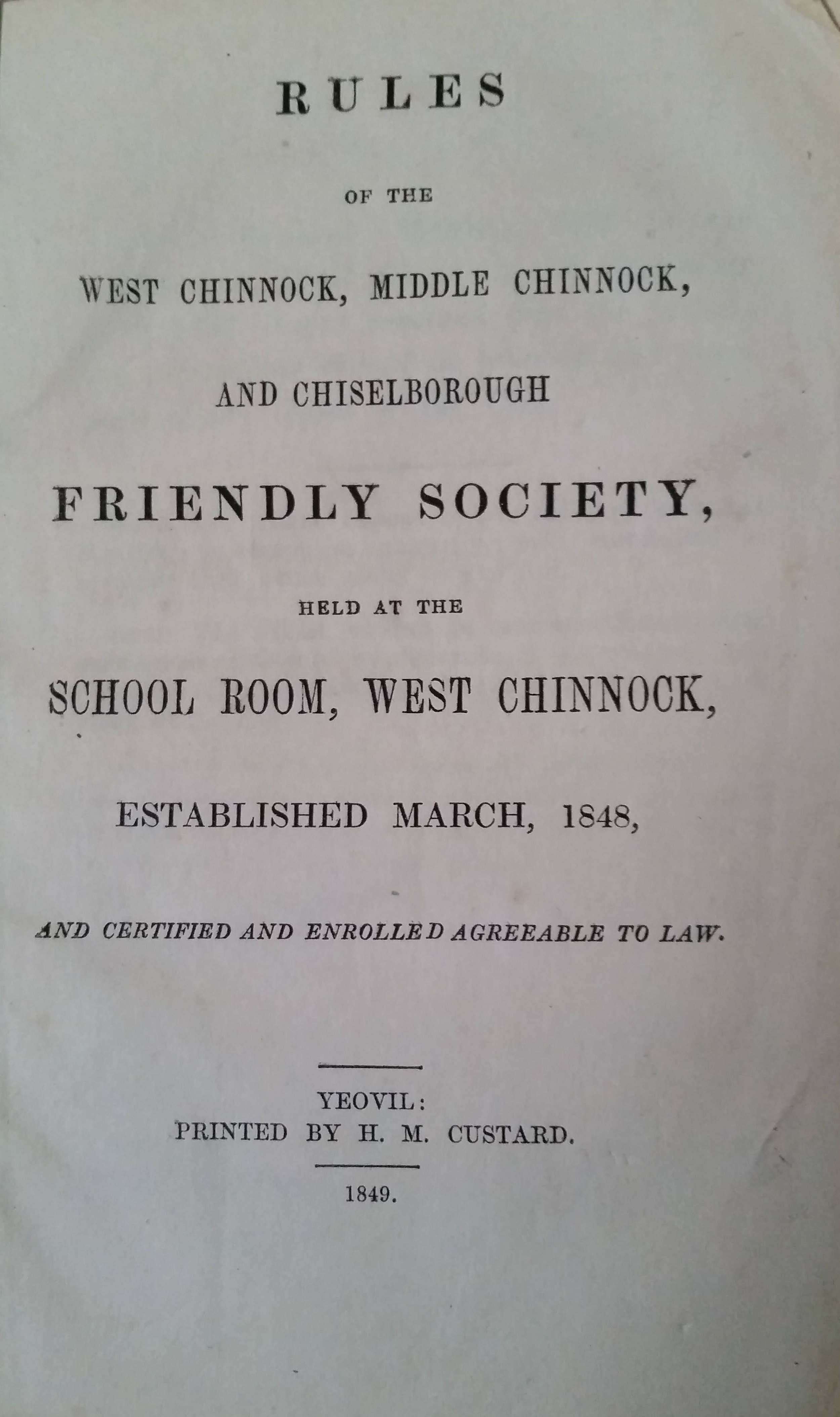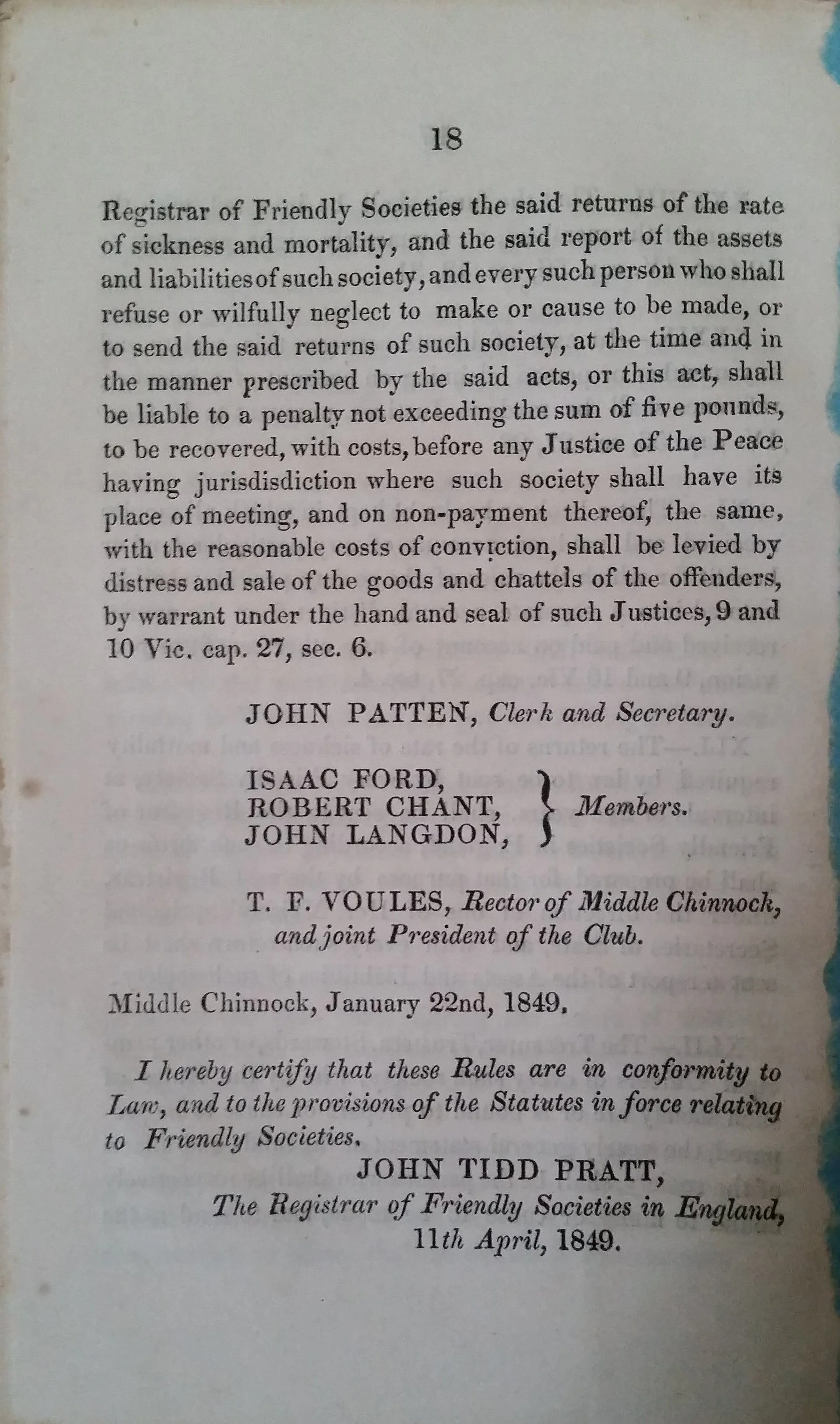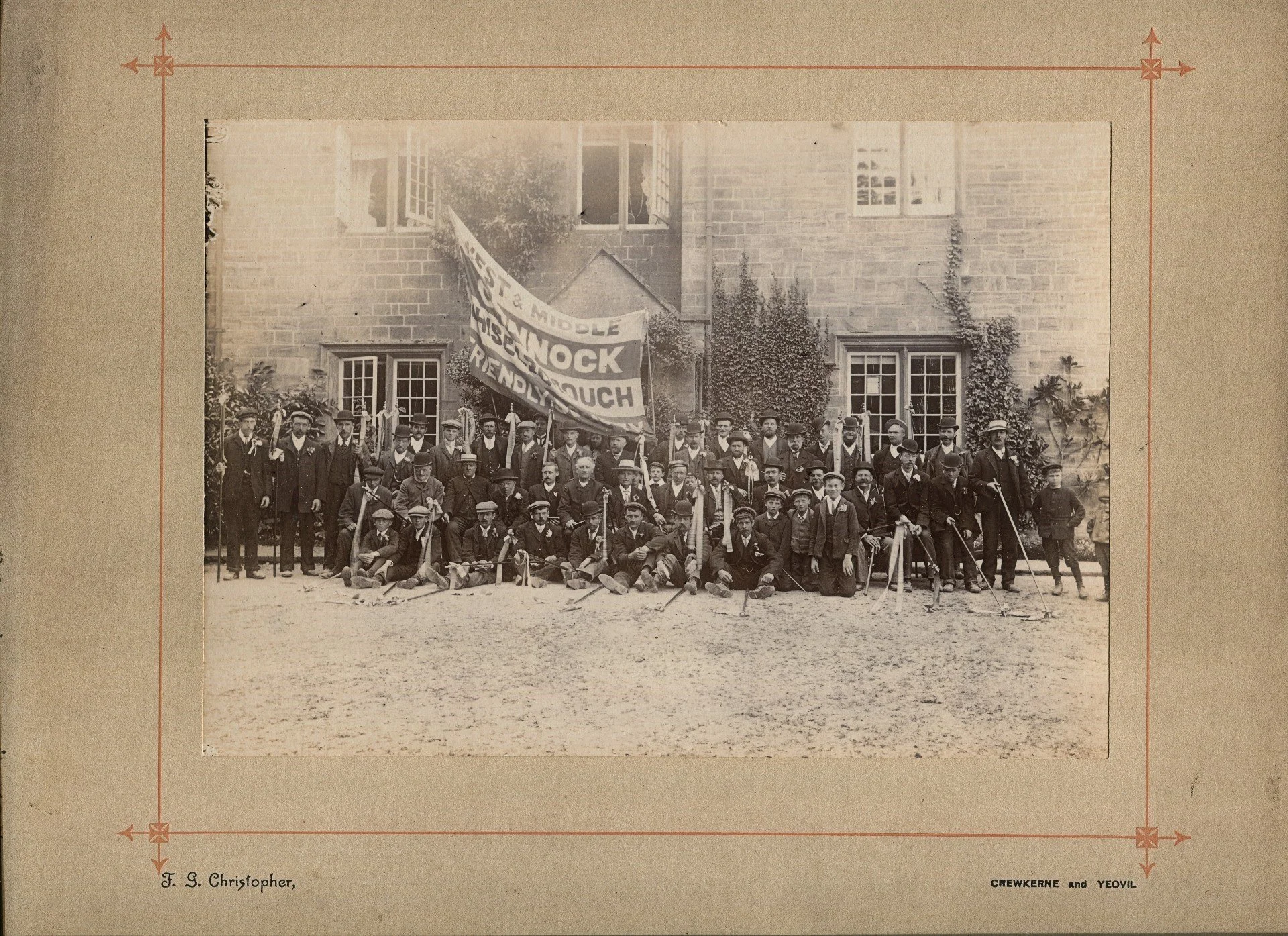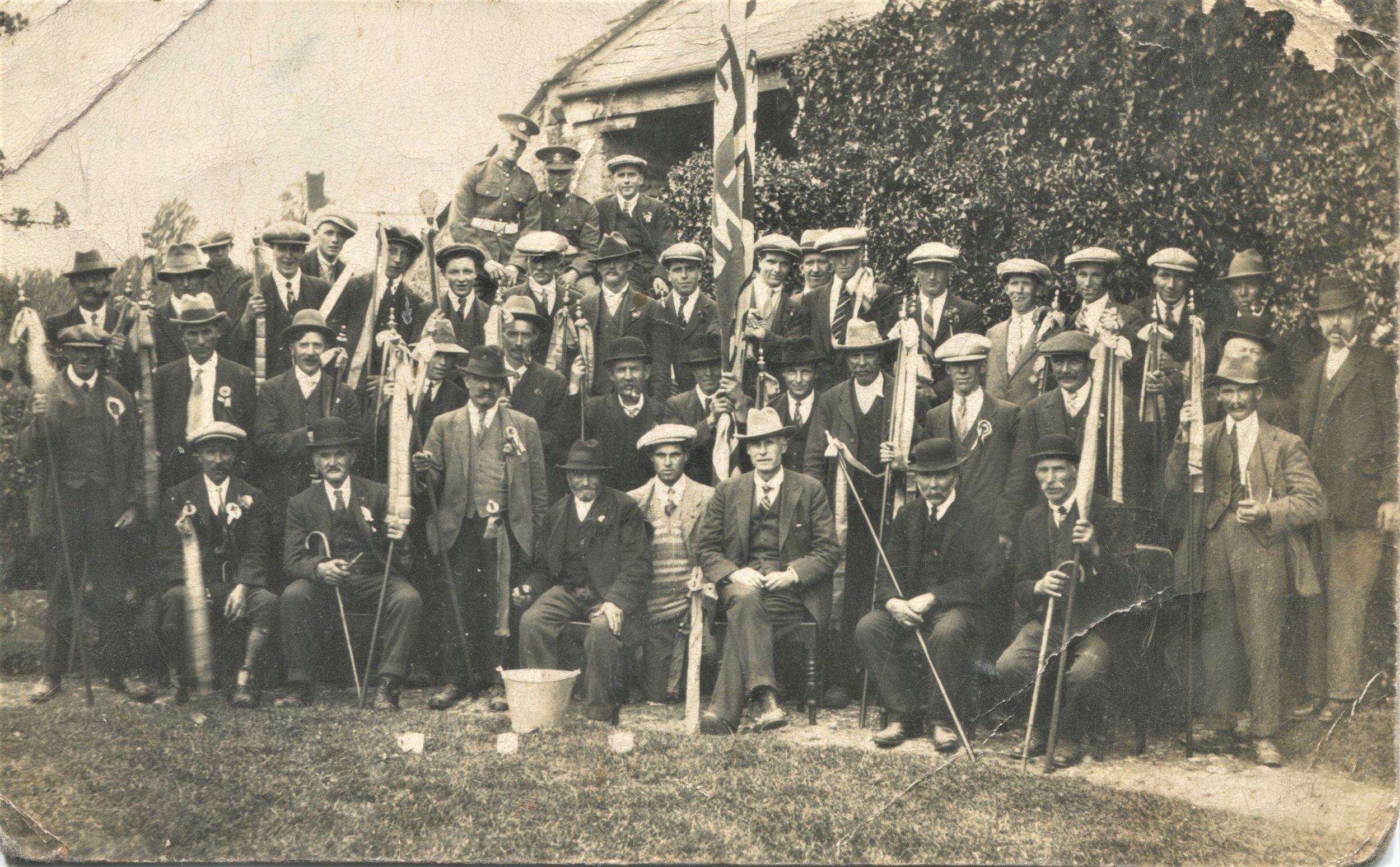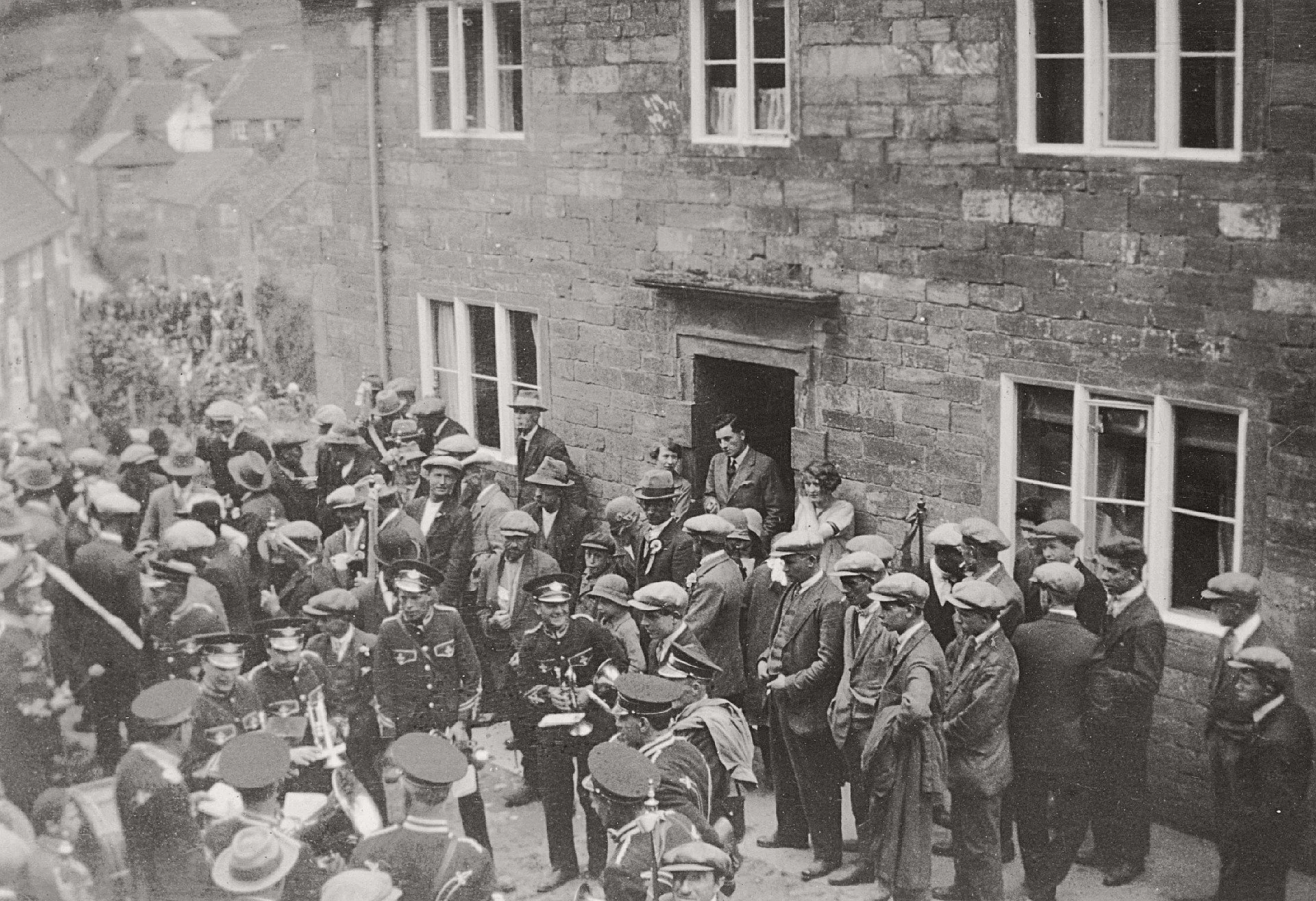Friendly Societies in Chiselborough
—by Phil Nichols
The earliest friendly society in the village is known to have been established at a meeting held in the School Room in West Chinnock in March 1848. This was formed “by men of good report of the parishes of West Chinnock, Middle Chinnock, and Chiselborough” and received support from the local clergy and prominent residents : the link with the Chinnocks was almost certainly due to the shared minister. George B Garrow was, at this time, Rector of both Chiselborough and West Chinnock, and he was appointed the first President of the West and Middle Chinnock and Chiselborough Friendly Society, jointly with Rev Francis P Voules of Middle Chinnock. A copy of the original 1848 rules of the Society were reprinted in 1897, when 7 of the original 42 rules were revised.
Above : a copy of the first and last pages of the 1849 booklet : the original rules were reprinted facsimile in the 1897 booklet. Of the signatories, John Patten (1794-1869) was a surveyor, and Isaac Ford (1785-1864) was a sailcloth manufacturer, both living in West Chinnock.
In the mid-19th century before trade unions for agricultural workers were established and became accepted, friendly societies were a key source of community support, especially in rural villages. The aim of the Chinnocks and Chiselborough Society was “to provide for the comfortable relief of each other in times of sickness, lameness, or any incapacity of getting a subsistence”. Although there are no minutes of the Society until 1856, it clearly attracted a healthy membership between the three parishes and continued in existence until 1939.
The payments required of members from the outset were : 1s 2d on admission as a member, and 1s 3d each month; further payments were required to the burial fund on the death of a member (1s) or a member’s wife or widow (6d). The main benefit was a weekly allowance when unable to work due to illness (5s for the first 4 weeks, 4s for the next 4 weeks, and 3s beyond 8 weeks). A payment of the members’ levy was made to a member whose wife had died, or to the widow on the death of a member. Payment to members about to emigrate were made on a pro-rata basis. In addition, the excess funds of the Society were divided between members on a 7-year basis. An example of this was shown in 1883, when £184 was distributed amongst 56 members. The longest serving, in this 7 year period, received £3 8s; during the previous 7 years, £129 had been paid to sick members, one having £24 12s, one £21 8s and a third £9 5s. It’s clear from reports in the 1920s and 1930s that the Club benefitted greatly from donations from honorary members : this amounted to £18 in 1927/28, and it was noted that there were 36 honorary members in 1931.
The highlight of the year for the Society was the ‘Club Day’ walk and dinner, this being held on Whit Monday, which usually fell in late May or early June, being seven weeks after Easter. The day started with a roll call of the members at 10am, who then marched to one of the three churches, rotated each year; from 1904, members attended a service on Whit Sunday, the day before the walk. Following the service, members would march to ‘pay visits’ to the houses of prominent villagers, who were expected to provide liquid refreshments. The newspaper reports often listed the visits made, such as in 1910 : firstly Chiselborough : Rev Chesshire (Rectory), Messrs B Rogers, G Hunt [near the New Inn], G Lemon, R A Clarke (Manor Farm), J Harrison (Secretary), J Masters [Strapp Farm], and F Dodge (Breach Farm); Middle Chinnock : Messrs J T Clarke [Manor Farm] and Woolcott [Broadstone], then Messrs Patten, Cave [shop in Higher Street], Pattemore, T Langdon, and T Mudford, at West Chinnock. Club members would carry staves with the club polehead, decorated with blue ribbons, and two members would carry the large flag. The march would be headed by a band from a local town or village : the first noted was the Bridport Town band in 1856, followed by bands from Beaminster, Seavington, Parrett Works, and, in later years, often the Star of the West band from Crewkerne. Club Day also included a dinner at West Chinnock School – the Club House – and this was usually provided by one of the local innkeepers, such as the Lowman and then the Warry family at the Half Moon : in 1862, it was resolved that “a plain dinner be provided for the members, their visitors and the Band, with meat, vegetables, bread and cheese, but no puddings”. Following the dinner, there were often more visits made and then dancing and other amusements on paddocks at the centre of the village, or on the lawns of large properties, such as The Elms in Lower Street, West Chinnock.
Club Day walk visiting Chiselborough Rectory in about 1910; Mark Dodge (1874-1936) of Chiselborough is seen in front of the window on the left and the Rector – Rev Howard S Chesshire (1857-1929; Rector 1904-1919) – in the centre. Several men from West and Middle Chinnock have been identified.
Club Day walk at Manor Farm, Chiselborough, probably in 1924; the band accompanying the marchers was the Star of the West band from Crewkerne, some of them seen at the rear. The farmer, Robert Ash Clarke (1848-1928) can just be seen in the doorway.
Club Day walk, possibly during 1926; Mark Dodge is seated in the front row (second from the left), and his elder brother Frank (1857-1930) is standing next to him. George Langdon (1850-1928), the shopkeeper for many years in Higher Street, West Chinnock, is seated to the right of Frank Dodge.
While the ‘club house’ was at West Chinnock, it’s clear that the Society was well supported by Chiselborough members. While this is difficult to confirm in the absence of membership lists, the arrangements for the Club Doctor give a good indication of support from Chiselborough : Dr Walter from Stoke-sub-Hamdon looked after all Club members until 1890, when it was decided to additionally use a doctor from Crewkerne. However, most Chiselborough members remained with Dr Walter, and a few years later, it was noted that Dr Alford of Crewkerne looked after 23 members, and Dr Walter was responsible for 37 members. The committee members, listed in a newspaper report in 1910, included several men from Chiselborough : Ernest Raison, Mark Dodge, Fred Hockey, George Holland, Ben Ford, and Ben Best, as well as three or four from West & Middle Chinnock (Western Chronicle, 20 May 1910). A few years later, Andrew Holland, the shepherd at Manor Farm, Chiselborough, was described as “practically the father of the club”, following his death in February 1923. Joseph Harrison (1861-1950), farmer and builder of Pendennis Farm, was the Club Secretary from 1909 to 1931.
Club Day at Pendennis Farm, Chiselborough, home of Joseph Harrison, the Club Secretary; it is thought that this was during the walk of 1929; it’s not known if Joseph Harrison was in this photograph. If this was 1929, this was the last of eight consecutive years that the Star of the West Band from Crewkerne played on Club Day.
The Club Day walk resumed in 1920, after the war had led to cancellations in 1915-1919. The number of club members initially rose, but a downward trend set in by 1924, so that in 1934, it was noted that “the annual festival of the local Friendly Society had this year to be abandoned owing to an insufficient number of members to warrant it being held”. Dances were held in the next few years, but no Club Day walk, and the Society was eventually dissolved in February 1939.
Although relatively little is known about them, there were other Friendly Societies in the village :
a) Victoria Friendly Benefit Club : this was a non-walking Club, and mention of the Club was made in newspaper articles in 1871-1874, and 1883. However, none of the reports clarify whether the Club derived its membership from villages other than West Chinnock
b) West & Middle Chinnock & Chiselborough Female Friendly Society : a meeting had been held in January 1860 to consider setting up a Female Friendly Society, but it took until 1874 before it was established. Meetings were reported in many years between 1881-1899, but no other records have been found. By 1886, the club had 40 members, with a strong representation from Chiselborough : the President was Mrs Newell, the wife of the Rector, and the Treasurer was Mrs Martha Templeman, wife of George D Templeman of Manor Farm, Chiselborough. Unlike the men’s club, they took their lunch at Chiselborough School Room that year. Like the men, they marched through the villages, in 1884 with the Merriott Brass Band, and it was noted that members ‘wore white dresses, with sashes of blue and bonnets to match’
c) Chiselborough Friendly Society : a record of this society has been found only in newspaper reports of 1886 and 1890. The first of those (Western Chronicle, 31 Dec 1886) indicates that it had been in existence for a few years by that time : the Chiselborough Friendly Society, which “has been established at the New Inn for some years past, celebrated their anniversary” two days before Christmas, with 60 people sitting down for a dinner. The officers were the Treasurer, George D Templeman of Manor Farm, and the Secretary, B Harrison, probably Benjamin Harrison (1859-1936), a builder and elder brother of Joseph Harrison. The Society was described as an “annual one”, so the excess funds were divided each year; £2 had been paid to sick members during the year, but there had been no deaths of members during that time. It was reported that “some capital songs were sung”. Four years later, it was reported that the Chiselborough Friendly Society again held their Christmas Eve anniversary dinner at the New Inn, and this was attended by 50 members out of the total of 64. B Harrison was still the Secretary, but the division of funds was disappointing, as “each member received back 11s of the 13s paid in, owing to so much sickness in the past twelve months”(Western Gazette, Jan 3 1890). No further reports have been found, and it may be that members transferred their allegiance to the West & Middle Chinnock and Chiselborough Friendly Society.
The photos at Manor Farm and Pendennis Farm have been supplied by Tony Perry; all other images by Phil Nichols.
